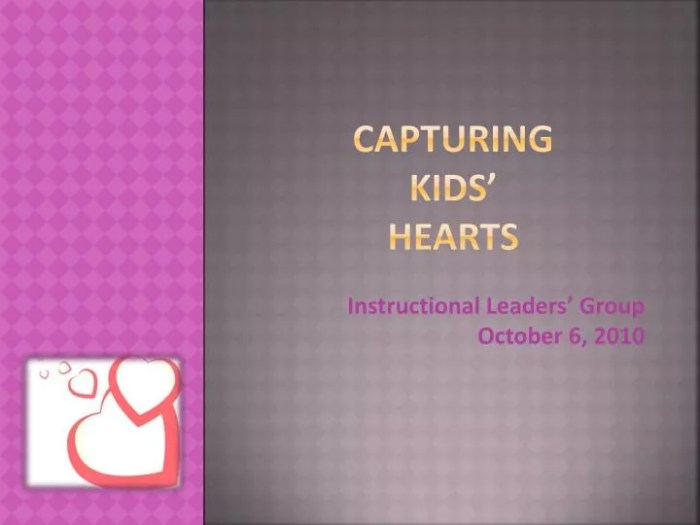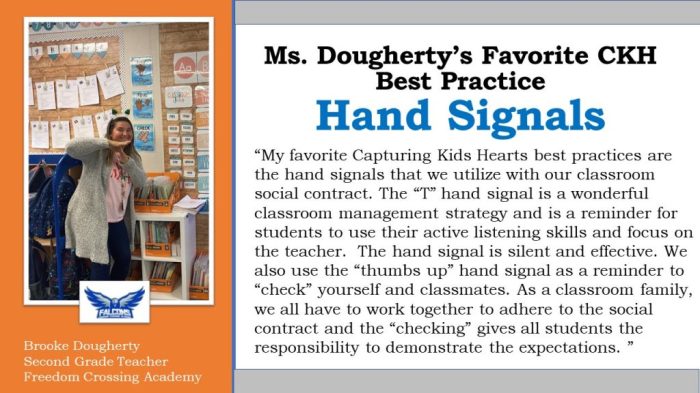Capturing kids hearts hand signals – Capturing Kids’ Hearts: Hand Signals uncovers the fascinating world of nonverbal communication among children, delving into its historical roots, cultural variations, developmental significance, educational applications, and ethical implications.
Hand signals serve as a vibrant tapestry woven into the fabric of childhood, facilitating communication, fostering social interaction, and shaping cognitive and emotional growth. This guide explores the nuances of these hand gestures, providing educators, parents, and caregivers with invaluable insights into their usage and impact.
Hand Signal Meanings

Hand signals are a form of non-verbal communication used by children to express their thoughts, feelings, and intentions. These signals can vary in meaning depending on the context and culture in which they are used. Some common hand signals include:
- Thumbs up:A sign of approval or agreement.
- Thumbs down:A sign of disapproval or disagreement.
- Waving hand:A gesture of greeting or farewell.
- Fist:A sign of anger or aggression.
- Peace sign:A gesture of peace or friendship.
History and Evolution of Hand Signals
The use of hand signals by children has a long history, dating back to ancient times. In many cultures, hand signals were used as a way to communicate over long distances or in noisy environments. Over time, these signals have evolved and adapted to the needs of children, becoming a vital part of their communication repertoire.
Some of the key moments that influenced the development of hand signals include:
- The development of sign language, which provided a standardized set of hand signals for deaf children.
- The rise of mass media, which exposed children to a wider range of hand signals.
- The development of educational programs that incorporated hand signals into their curriculum.
Role in Child Development, Capturing kids hearts hand signals
Hand signals play an important role in child development, facilitating communication, social interaction, and learning.
- Communication:Hand signals allow children to express themselves even before they have developed the ability to speak.
- Social interaction:Hand signals can be used to initiate and maintain social interactions, such as greeting friends or asking for help.
- Learning:Hand signals can be used to reinforce concepts taught in the classroom, such as numbers or letters.
Cultural Variations
Hand signals can vary significantly across cultures, reflecting the unique values and beliefs of each society.
- In some cultures, the thumbs up gesture is considered a sign of approval, while in others it is considered a sign of insult.
- The peace sign, which is commonly used in Western cultures to symbolize peace, can be considered offensive in some Asian cultures.
- The fist, which is often used as a sign of anger or aggression in Western cultures, can be used as a sign of solidarity or support in some African cultures.
Educational Applications
Hand signals can be a valuable tool in educational settings, providing a way for teachers to communicate with students without interrupting the flow of instruction.
Here is a table with examples of hand signals that can be used in educational settings:
| Hand Signal | Meaning |
|---|---|
| Thumbs up | I understand. |
| Thumbs down | I don’t understand. |
| Waving hand | I need help. |
| Fist | Stop talking. |
| Peace sign | I’m finished. |
Ethical Considerations
While hand signals can be a valuable tool, there are also some ethical considerations that must be taken into account when using them with children.
- Informed consent:It is important to obtain informed consent from children before using hand signals with them.
- Cultural sensitivity:It is important to be aware of the cultural context in which hand signals are being used.
- Privacy:Hand signals should not be used to collect personal information from children.
FAQ Compilation: Capturing Kids Hearts Hand Signals
What is the significance of hand signals in child development?
Hand signals play a crucial role in child development, facilitating communication, fostering social interaction, and enhancing cognitive and emotional growth.
How can hand signals be incorporated into educational settings?
Educators can incorporate hand signals into lesson plans to enhance communication, promote inclusivity, and support learning objectives.
What ethical considerations should be taken into account when using hand signals with children?
Ethical considerations include ensuring that hand signals are used respectfully, avoiding potential risks, and promoting responsible and appropriate usage.

